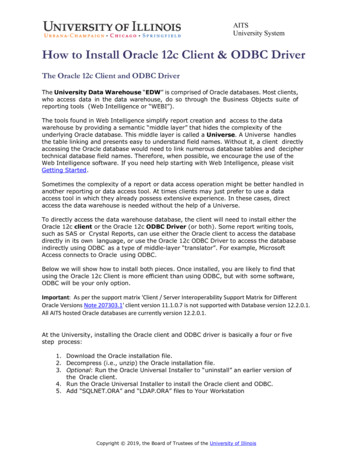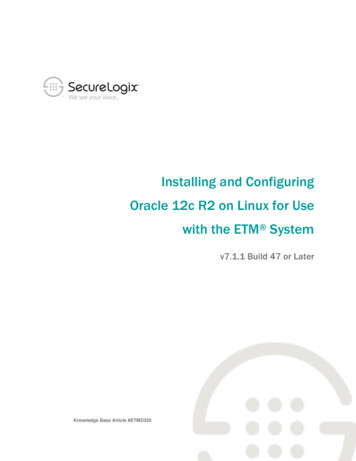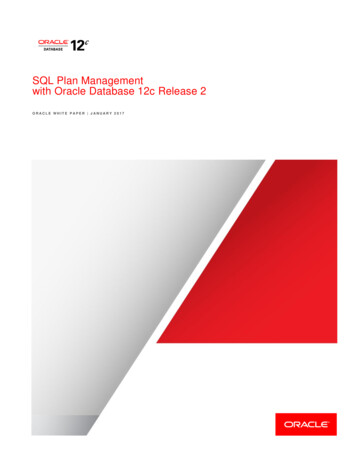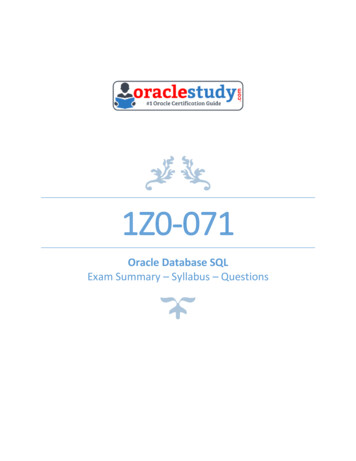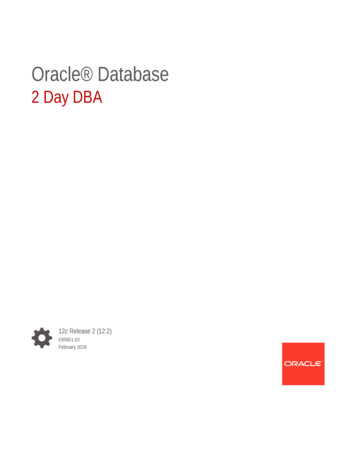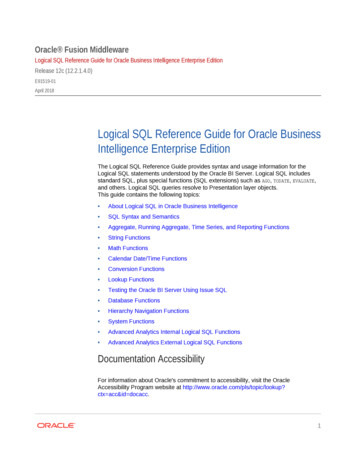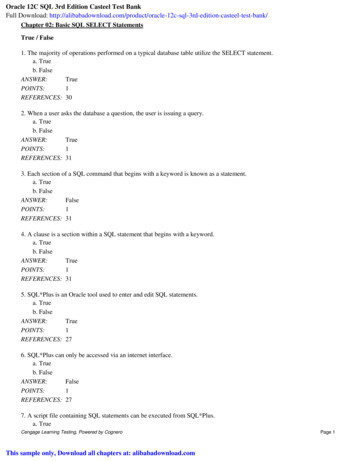
Transcription
Oracle 12C SQL 3rd Edition Casteel Test BankFull Download: 3rd-edition-casteel-test-bank/Chapter 02: Basic SQL SELECT StatementsTrue / False1. The majority of operations performed on a typical database table utilize the SELECT statement.a. Trueb. FalseANSWER:TruePOINTS:1REFERENCES: 302. When a user asks the database a question, the user is issuing a query.a. Trueb. FalseANSWER:TruePOINTS:1REFERENCES: 313. Each section of a SQL command that begins with a keyword is known as a statement.a. Trueb. FalseANSWER:FalsePOINTS:1REFERENCES: 314. A clause is a section within a SQL statement that begins with a keyword.a. Trueb. FalseANSWER:TruePOINTS:1REFERENCES: 315. SQL*Plus is an Oracle tool used to enter and edit SQL statements.a. Trueb. FalseANSWER:TruePOINTS:1REFERENCES: 276. SQL*Plus can only be accessed via an internet interface.a. Trueb. FalseANSWER:FalsePOINTS:1REFERENCES: 277. A script file containing SQL statements can be executed from SQL*Plus.a. TrueCengage Learning Testing, Powered by CogneroThis sample only, Download all chapters at: alibabadownload.comPage 1
Chapter 02: Basic SQL SELECT Statementsb. FalseANSWER:TruePOINTS:1REFERENCES: 278. The DESCRIBE command is used to view data in a table.a. Trueb. FalseANSWER:FalsePOINTS:1REFERENCES: 29309. A query is accomplished by issuing a SELECT statement.a. Trueb. FalseANSWER:TruePOINTS:1REFERENCES: 3110. The asterisk symbol (*) can be used in a SELECT statement to indicate that all rows in the table should be displayedin the results.a. Trueb. FalseANSWER:FalsePOINTS:1REFERENCES: 313211. A user can indicate that all columns of a table should be displayed in the results of a SELECT statement by includingan asterisk (*) in the SELECT clause.a. Trueb. FalseANSWER:TruePOINTS:1REFERENCES: 313212. Column headings may be truncated in the results of a SELECT statement.a. Trueb. FalseANSWER:TruePOINTS:1REFERENCES: 3213. The SELECT clause of the SELECT statement is used to identify which rows are to be retrieved from a specifiedCengage Learning Testing, Powered by CogneroPage 2
Chapter 02: Basic SQL SELECT Statementstable.a. Trueb. FalseANSWER:FalsePOINTS:1REFERENCES: 3114. Choosing specific columns to be displayed by a SELECT statement is known as selection.a. Trueb. FalseANSWER:FalsePOINTS:1REFERENCES: 3315. Choosing specific columns to be displayed by a SELECT statement is known as projection.a. Trueb. FalseANSWER:TruePOINTS:1REFERENCES: 3316. If a column name is entered in lower case in the SELECT statement, the data for the column will be displayed in lowercase in the results.a. Trueb. FalseANSWER:FalsePOINTS:1REFERENCES: 3417. If multiple column names are listed in the SELECT clause of a SELECT statement, the columns must be separated bya comma (,).a. Trueb. FalseANSWER:TruePOINTS:1REFERENCES: 343518. The columns displayed in the results of a SELECT statement will be in the same order as they are stored in thedatabase table.a. Trueb. FalseANSWER:FalsePOINTS:1REFERENCES: 35Cengage Learning Testing, Powered by CogneroPage 3
Chapter 02: Basic SQL SELECT Statements19. If you assign a column alias to a column, it must be enclosed in double quotation marks (" ").a. Trueb. FalseANSWER:FalsePOINTS:1REFERENCES: 3720. By default, a column alias is displayed in lower case characters in the results.a. Trueb. FalseANSWER:FalsePOINTS:1REFERENCES: 3721. The optional keyword AS can be used to indicate that the subsequent string of characters is a column alias.a. Trueb. FalseANSWER:TruePOINTS:1REFERENCES: 363722. The following arithmetic operations can be performed in the SELECT clause of a SELECT statement: addition ( ),subtraction (-), multiplication (*), division (/), and exponential ( ).a. Trueb. FalseANSWER:FalsePOINTS:1REFERENCES: 3923. Parentheses can be used to override the order of operations in an arithmetic expression.a. Trueb. FalseANSWER:TruePOINTS:1REFERENCES: 3924. The DIST or UNIQ keywords can be used to suppress duplicate data in the results of a SELECT statement.a. Trueb. FalseANSWER:FalsePOINTS:1REFERENCES: 424325. Concatenation refers to combining the results of several SELECT statements into one result.Cengage Learning Testing, Powered by CogneroPage 4
Chapter 02: Basic SQL SELECT Statementsa. Trueb. FalseANSWER:FalsePOINTS:1REFERENCES: 444526. A double backslash (\\) is used to indicate concatenation in a SELECT statement.a. Trueb. FalseANSWER:FalsePOINTS:1REFERENCES: 4445Modified True / False27. A(n) CRBMDS is a software program that can be used to create a relational database and allows you to enter,manipulate, and retrieve data.ANSWER:False - RDBMSPOINTS:1REFERENCES: 303128. A(n) WHERE statement allows a user to retrieve data from a database table.ANSWER:False - SELECTPOINTS:1REFERENCES: 303129. The syntax for a SQL statement gives the basic structure required to execute the statement.ANSWER:TruePOINTS:1REFERENCES: 303130. A query can be executed in the SQL*Plus tool.ANSWER:TruePOINTS:1REFERENCES: 303131. Each section of a statement that begins with a keyword is known as a(n) buffer.ANSWER:False - clausePOINTS:1REFERENCES: 31Cengage Learning Testing, Powered by CogneroPage 5
Chapter 02: Basic SQL SELECT Statements32. The only required clauses for a SELECT statement are the WHERE and FROM clauses.ANSWER:False - SELECTPOINTS:1REFERENCES: 3133. The ALL option can be used in the SELECT clause to indicate that all columns should be retrieved.ANSWER:False - *POINTS:1REFERENCES: 3134. Each clause of a SELECT statement must be entered on a new line in SQL*Plus.ANSWER:False - optionalPOINTS:1REFERENCES: 3135. The SELECT clause identifies the table containing the data to be queried.ANSWER:False - FROMPOINTS:1REFERENCES: 3136. A column heading that is longer than the width of a column will not be truncated for a column that is defined to storecharacter data.ANSWER:False - numericPOINTS:1REFERENCES: 3237. The SELECT command can be used to display the structure of a database table.ANSWER:False - DESCRIBEPOINTS:1REFERENCES: 2938. Choosing specific columns from a database through a SELECT statement is known as projection.ANSWER:TruePOINTS:1REFERENCES: 3339. In a(n) SELECT statement, keywords, table names, and column names are not case sensitive.ANSWER:TruePOINTS:1REFERENCES: 3140. When listing more than one column name in the SELECT clause of a SELECT statement, the column names must beCengage Learning Testing, Powered by CogneroPage 6
Chapter 02: Basic SQL SELECT Statementsseparated by semicolons.ANSWER:False - commasPOINTS:1REFERENCES: 343541. The use of a column alias in the SELECT clause can be designated by the keyword ALIAS.ANSWER:False - ASPOINTS:1REFERENCES: 363742. If a column alias contains a blank space, it must be enclosed in double quotation marks.ANSWER:TruePOINTS:1REFERENCES: 3743. By default, data within a numeric column is right-aligned when it is displayed.ANSWER:TruePOINTS:1REFERENCES: 3844. By default, data within a character or data column is right-aligned when it is displayed.ANSWER:False - leftPOINTS:1REFERENCES: 3845. Insignificant zeros are displayed for numeric columns by default to show two decimal places.ANSWER:False - are notPOINTS:1REFERENCES: 3946. When solving arithmetic expressions, Oracle 12c always resolves addition and subtraction operations first from left toright in the expression.ANSWER:False - lastPOINTS:1REFERENCES: 3947. Parentheses can be used to override the order of operations in an arithmetic expression.ANSWER:TruePOINTS:1REFERENCES: 39Cengage Learning Testing, Powered by CogneroPage 7
Chapter 02: Basic SQL SELECT Statements48. The DISTINCT keyword can be used to indicate that duplicate data should be suppressed in the results of a query.ANSWER:TruePOINTS:1REFERENCES: 4249. Combining the contents of two or more columns is known as projection.ANSWER:False - concatenationPOINTS:1REFERENCES: 444550. A string literal must be enclosed in double quotation marks.ANSWER:False - singlePOINTS:1REFERENCES: 45Multiple Choice51. Which of the following commands is used to issue a query?a. QUERb. FROMc. SELECTd. QUESTIONANSWER:cPOINTS:1REFERENCES: 3152. A(n) has a predefined meaning in Oracle 12c.a. statementb. clausec. keywordd. syntaxANSWER:aPOINTS:1REFERENCES: 3153. What is used to indicate the end of an SQL statement?a. :b. ;c. /d. *ANSWER:cPOINTS:1REFERENCES: 31Cengage Learning Testing, Powered by CogneroPage 8
Chapter 02: Basic SQL SELECT Statements54. The for a SQL statement gives the basic structure, or rules, required to execute the statement.a. keywordsb. sequencec. syntaxd. clausesANSWER:bPOINTS:1REFERENCES: 3155. To indicate which database table contains the data to be selected by a query, the table name should be listed in theclause.a. WHEREb. SELECTc. HAVINGd. FROMANSWER:dPOINTS:1REFERENCES: 3156. Which of the following is a mandatory clause in a SELECT statement?a. both a and b are mandatoryb. HAVINGc. WHEREd. FROMANSWER:dPOINTS:1REFERENCES: 3157. Which of the following symbols represents all the columns contained in a table?a. b. ;c. *d. /ANSWER:cPOINTS:1REFERENCES: 3158. The entire column heading for a column will be displayed, regardless of the assigned width of the column, if thecolumn is defined as a(n) column.a. numericb. alphanumericc. characterd. dateANSWER:aPOINTS:1Cengage Learning Testing, Powered by CogneroPage 9
Chapter 02: Basic SQL SELECT StatementsREFERENCES: 3359. Which of the following commands can be used to view the structure of a table?a. SELECTb. DESCRIBEc. none of the aboved. CONCATENATIONANSWER:bPOINTS:1REFERENCES: 293060. Which of the following are case sensitive in Oracle 12c?a. none of the aboveb. table namesc. column namesd. keywordsANSWER:aPOINTS:1REFERENCES: 313261. If the results of a SELECT statement include more than one column of data, the column names must be separated inthe SELECT clause by which of the following symbols?a. " "b. ' 'c. *d. ,ANSWER:dPOINTS:1REFERENCES: 3462. Which of the following statements is correct?a. The columns will be listed in the results in the same order they are listed in the SELECT clause of theSELECT statement.b. The columns will be listed in the results in the same order they are stored in the database table.c. Numeric columns are listed first in the output, followed by character columns.d. Character columns are listed first in the output, followed by numeric columns.ANSWER:aPOINTS:1REFERENCES: 3563. Which of the following keywords can be used to indicate that a column alias should be included in the results?a. ALIASb. ASc. SELECTCengage Learning Testing, Powered by CogneroPage 10
Chapter 02: Basic SQL SELECT Statementsd. FROMANSWER:bPOINTS:1REFERENCES: 3764. If a column alias contains a blank space, it must be enclosed in .a. single quotation marks (' ')b. asterisks (* *)c. double quotation marks (" ")d. percent signs (% %)ANSWER:cPOINTS:1REFERENCES: 3665. A column alias must be contained within double quotation marks (" ") if it contains which of the following?a. blank spacesb. special symbolsc. characters that should be displayed in lower or mixed cased. all of the aboveANSWER:dPOINTS:1REFERENCES: 3666. Which of the following types of columns will automatically right-align the data when it is displayed?a. numericb. characterc. alphanumericd. dateANSWER:aPOINTS:1REFERENCES: 3867. Which of the following types of columns will automatically left-align the column heading when it is displayed?a. dateb. characterc. both a and cd. numericANSWER:cPOINTS:1REFERENCES: 3868. What is the correct answer for the arithmetic expression 9 2*3-2 using the order of operations employed by Oracle12c when solving equations?a. 13b. 10Cengage Learning Testing, Powered by CogneroPage 11
Chapter 02: Basic SQL SELECT Statementsc. 12d. 31ANSWER:aPOINTS:1REFERENCES: 3969. What is the correct solution for the arithmetic expression 2 8/2*9/3 using the order of operations employed by Oracle12c when solving equations?a. 14b. 15c. 4.8d. 0.1ANSWER:aPOINTS:1REFERENCES: 3970. What is the correct answer for the arithmetic expression 9 2*(3-4) using the order of operations employed by Oracle12c when solving equations?a. 7b. -18c. 9d. -11ANSWER:aPOINTS:1REFERENCES: 3971. What is the correct solution for the arithmetic expression (2 8)/2*9/3 using the order of operations employed byOracle 12c when solving equations?a. 4.8b. 15c. 14d. 1.336ANSWER:bPOINTS:1REFERENCES: 3972. Which of the following keywords can be included in a SELECT statement to suppress duplicate data?a. UNIQb. SUPPRESSc. all of the aboved. DISTINCTANSWER:dPOINTS:1REFERENCES: 42Cengage Learning Testing, Powered by CogneroPage 12
Chapter 02: Basic SQL SELECT Statements73. Which of the following symbols can be used to combine data from different columns into one column of output?a. *b. %c. d. ANSWER:cPOINTS:1REFERENCES: 444574. Combining the contents of two or more columns is known as .a. selectionb. concatenationc. suppressiond. projectionANSWER:bPOINTS:1REFERENCES: 444575. A string literal must be enclosed in .a. single quotation marks (' ')b. double quotation marks (" ")c. asterisks (* *)d. percent signs (% %)ANSWER:aPOINTS:1REFERENCES: 46Contents of the PUBLISHER table76. Based upon the contents of the PUBLISHER table, which of the following SELECT statements will display thepublisher's name first in the results?a. SELECT * FROM publisher;b. SELECT name, publisherID FROM publishers;c. SELECT pubid, contact FROM publisher;d. none of the aboveANSWER:dCengage Learning Testing, Powered by CogneroPage 13
Chapter 02: Basic SQL SELECT StatementsPOINTS:1REFERENCES: 313577. Based upon the contents of the PUBLISHER table, which of the following is not a valid SQL statement?a. SELECT name, phone FROM publisherb. SELECT *FROM publisher;c. SELECT name, contact FROM publisher/d. SELECT * FROM publisher;ANSWER:cPOINTS:1REFERENCES: 343578. Based upon the contents of the PUBLISHER table, which of the following is a valid SQL statement?a. SELECT contact Contact's NameFROM publisher;b. SELECT publisherIDFROM publisher;c. SELECT contact, nameFROM publisher;d. SELECT nameFROM publishers;ANSWER:cPOINTS:1REFERENCES: 343579. Based upon the contents of the PUBLISHER table, which of the following is a valid SQL statement?a. SELECT * FROM contact;b. SELECT * FROM publisher;c. SELECT * FROM pubid;d. SELECT * FROM name;ANSWER:bPOINTS:1REFERENCES: 313280. Based upon the contents of the PUBLISHER table, which of the following SQL statements will display only twocolumns in the results?a. SELECT * FROM publisher;b. none of the abovec. SELECT contact name FROM publisher;d. SELECT contact person, name FROM publisher;ANSWER:dCengage Learning Testing, Powered by CogneroPage 14
Chapter 02: Basic SQL SELECT StatementsPOINTS:1REFERENCES: 343581. Based upon the contents of the PUBLISHER table, which of the following SQL statements will execute withoutreturning an error message?a. SELECT pubid PUBLISHERID name FROM publisher;b. SELECT pubid "PUBLISHER ID" name FROM publisher;c. SELECT pubid name FROM publisher;d. all of the aboveANSWER:cPOINTS:1REFERENCES: 3437Contents of the BOOKS table82. Which of the following SQL statements will display the profit generated by each book currently stored in the BOOKStable?a. SELECT title, retail, cost profit FROM books;b. SELECT title, retail-cost FROM books;c. all of the aboved. SELECT * FROM books;ANSWER:bPOINTS:1REFERENCES: 3983. Based upon the contents of the BOOKS table, which of the following columns will be displayed with a right-alignedcolumn heading?a. titleb. pubdatec. categoryd. pubidANSWER:dPOINTS:1Cengage Learning Testing, Powered by CogneroPage 15
Chapter 02: Basic SQL SELECT StatementsREFERENCES: 3884. Based upon the contents of the BOOKS table, which of the following is a valid SQL statement?a. select * FROM pubid;b. select pubid, "Publisher ID" from books;c. select pubid, isbn, from books;d. none of the aboveANSWER:dPOINTS:1REFERENCES: 313585. Which of the following is a valid SQL statement?a. SELECT DISTINCT title, category FROM books/b. all of the abovec. SELECT title, retail-cost FROM books;d. SELECT title, retail-cost "Profit"ANSWER:cPOINTS:1REFERENCES: 3986. Based upon the contents of the BOOKS table, which of the following SQL statements will display two columns in itsoutput?a. SELECT DISTINCT title FROM books;b. all of the abovec. SELECT * FROM books;d. SELECT title, retail-cost "Profit" FROM books;ANSWER:dPOINTS:1REFERENCES: 373987. Which of the following will display the ISBN column of the BOOKS table as the first column in its results?a. both a and c aboveb. SELECT ISBN, title FROM books;c. SELECT * FROM books;d. SELECT DISTINCT category, ISBN FROM books;ANSWER:aPOINTS:1REFERENCES: 3588. Based upon the contents of the BOOKS table, which of the following SQL statements will display five rows in itsresults?a. SELECT UNIQUE pubid, title FROM books;b. both b and cc. SELECT DISTINCT pubid FROM books;Cengage Learning Testing, Powered by CogneroPage 16
Chapter 02: Basic SQL SELECT Statementsd. SELECT DISTINCT category FROM books;ANSWER:cPOINTS:1REFERENCES: 4289. Which of the following will display the new retail price of each book as 20 percent more than it originally cost?a. none of the aboveb. SELECT title, cost .20 "New Retail Price" FROM books;c. SELECT title, cost*.20 "New Retail Price" FROM books;d. SELECT title, cost*1.20 "New Retail Price" FROM books;ANSWER:dPOINTS:1REFERENCES: 363990. Based upon the contents of the BOOKS table, which of the following SQL statements will display the retail price fortwo copies of each book currently in inventory?a. SELECT * FROM books;b. SELECT title, retail retail FROM books;c. none of the aboved. SELECT title, retail 2 FROM books;ANSWER:bPOINTS:1REFERENCES: 39Structure of the ORDERS table91. Based upon the structure of the ORDERS table, which of the following is a valid SQL statement?a. none of the aboveb. SELECT customer # FROM orders;c. SELECT "order#", "customer#" FROM orders;d. SELECT order#, orderdate DateOrdered FROM orders;ANSWER:dPOINTS:1REFERENCES: 3539Cengage Learning Testing, Powered by CogneroPage 17
Chapter 02: Basic SQL SELECT Statements92. Based upon the structure of the ORDERS table, the column heading for which column will be truncated in the results?a. shipstreetb. orderdatec. customer#d. shipzipANSWER:dPOINTS:1REFERENCES: 3393. Which of the following is a valid SQL statement to retrieve data from the ORDERS table?a. all of the aboveb. SELECT order#, orderdate, shipdate FROM orders;c. SELECT customer#, street, city, state, zip FROM orders;d. SELECT DISTINCT customer#, DISTINCT order# FROM orders;ANSWER:bPOINTS:1REFERENCES: 3594. Which of the following is a valid SELECT statement?a. SELECT order# ' was shipped on ' shipdate;b. SELECT order# " was shipped on " shipdate;c. none of the aboved. SELECT order#, ' was shipped on ' shipdate;ANSWER:cPOINTS:1REFERENCES: 4295. Which of the following statements can be used to view the structure of the ORDERS table?a. SELECT * FROM orders;b. LIST ORDERS;c. DESCRIBE ORDERSd. none of the aboveANSWER:cPOINTS:1REFERENCES: 2996. Based upon the structure of the ORDERS table, which of the following SQL statements will return an error messageupon execution?a. SELECT order#, "order number" FROM orders;b. SELECT order# customer# FROM orders;c. SELECT * FROM orders;d. both b and cANSWER:aPOINTS:1REFERENCES: 37Cengage Learning Testing, Powered by CogneroPage 18
Chapter 02: Basic SQL SELECT StatementsCompletion97. statements can be used to retrieve data from database tables.ANSWER:SELECTPOINTS:1REFERENCES: 303198. A is used to end a SQL statement.ANSWER:semicolonPOINTS:1REFERENCES: 3199. The name of the table containing the data to be retrieved is specified in the clause.ANSWER:FROMPOINTS:1REFERENCES: 31100. The names of the columns to be retrieved are listed in the clause.ANSWER:SELECTPOINTS:1REFERENCES: 31101. A SELECT statement is also referred to as a .ANSWER:queryPOINTS:1REFERENCES: 31102. If a column heading is longer than the assigned width of a(n) field, the column heading willbe truncated.ANSWER:characterPOINTS:1REFERENCES: 33103. If a column heading is longer than the assigned width of a character column, the column heading will be.ANSWER:truncatedPOINTS:1REFERENCES: 33104. Choosing specific columns in a SELECT statement is known as .ANSWER:projectionPOINTS:1REFERENCES: 33105. A(n) is an alternative column heading displayed in the output of a query.Cengage Learning Testing, Powered by CogneroPage 19
Chapter 02: Basic SQL SELECT StatementsANSWER:column aliasPOINTS:1REFERENCES: 36106. The optional keyword can be used to distinguish between a column name and a columnalias.ANSWER:ASPOINTS:1REFERENCES: 37107. If you do not want a column alias to appear in all upper case characters, the column alias must be enclosed inmarks.ANSWER:double quotationPOINTS:1REFERENCES: 37108. By default, the data for character fields are displayed aligned when they are displayed.ANSWER:leftleftPOINTS:1REFERENCES: 38109. By default, the data for a numeric column is aligned when it is displayed.ANSWER:rightrightPOINTS:1REFERENCES: 38110. You can include to override the order of operations when solving arithmetic : 39111. The keyword can be included in a SELECT statement to suppress the display of CES: 42112. Combining the contents of two or more columns is known as .ANSWER:concatenationPOINTS:1REFERENCES: 4445Cengage Learning Testing, Powered by CogneroPage 20
Chapter 02: Basic SQL SELECT Statements113. A(n) can consist of numbers, characters, or special symbols that should be included in theoutput exactly as entered by the user.ANSWER:string literalPOINTS:1REFERENCES: 46114. A string literal must be enclosed in marks.ANSWER:single quotationsingle-quotation''POINTS:1REFERENCES: 46115. In an arithmetic expression, multiplication and are always solved first in Oracle 12c.ANSWER:divisionPOINTS:1REFERENCES: 39116. When resolving arithmetic expressions, Oracle 12c always performs the operations by starting on theside of the expression.ANSWER:leftPOINTS:1REFERENCES: 39117. The command can be used to display the structure of a table.ANSWER:DESCRIBEPOINTS:1REFERENCES: 29118. A(n) is included in the SELECT clause to indicate that all columns in the specified tableshould be listed in the results.ANSWER:asterisk*POINTS:1REFERENCES: 3132Essay119. When should double-quotation marks (" ") be used in a SELECT statement?ANSWER:Double-quotation marks are used when a column alias included in the SELECT statement contains blankspaces, special symbols, or to indicate that the column alias should be displayed in lower or mixed case.POINTS:1REFERENCES: 37120. What are the mandatory clauses of a SELECT statement and what do they represent?ANSWER:The only mandatory clauses of a SELECT statement are the SELECT and FROM clauses. The SELECTclause is used to indicate the columns that are to be displayed in the results while the FROM clause isCengage Learning Testing, Powered by CogneroPage 21
Oracle 12C SQL 3rd Edition Casteel Test BankFull Download: 3rd-edition-casteel-test-bank/Chapter 02: Basic SQL SELECT Statementsused to indicate the table containing the data to be displayed.POINTS:1REFERENCES: 31121. Explain how the DISTINCT keyword effects a SELECT statement that lists two columns in the SELECT clause.ANSWER:The DISTINCT keyword will only suppress duplicate data if the combination of the data in the twocolumns is duplicated. If the combination of data in the referenced columns is unique for each record inthe table, then each record will still be displayed in the results.POINTS:1REFERENCES: 4243Cengage Learning Testing, Powered by CogneroThis sample only, Download all chapters at: alibabadownload.comPage 22
3. Each section of a SQL command that begins with a keyword is known as a statement. a. True b. False ANSWER: False POINTS: 1 REFERENCES: 31 4. A clause is a section within a SQL statement that begins with a keyword. a. True b. False ANSWER: True POINTS: 1 REFERENCES: 31 5. SQL*Plus is an Oracle tool used




